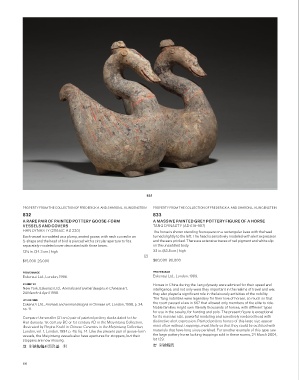Page 68 - 2019 September 13th Christie's New York Important Chinese Works of Art
P. 68
832
PROPERTY FROM THE COLLECTION OF FREDERICK A. AND SHARON L. KLINGENSTEIN PROPERTY FROM THE COLLECTION OF FREDERICK A. AND SHARON L. KLINGENSTEIN
832 833
A RARE PAIR OF PAINTED POTTERY GOOSE-FORM A MASSIVE PAINTED GREY POTTERY FIGURE OF A HORSE
VESSELS AND COVERS TANG DYNASTY (AD 618-907)
HAN DYNASTY (206 BC-AD 220) The horse is shown standing foursquare on a rectangular base with the head
Each vessel is modeled as a plump, seated goose, with neck curved in an turned slightly to the left. The head is sensitively modeled with alert expression
S-shape and the head of bird is pierced with a circular aperture to ft a and the ears pricked. There are extensive traces of red pigment and white slip
separately-modeled cover decorated with three bears. on the unsaddled body.
13Ω in. (34.3 cm.) high 33 in. (83.8 cm.) high
(2)
$15,000-25,000 $60,000-80,000
PROVENANCE PROVENANCE
Eskenazi Ltd., London, 1998. Eskenazi Ltd., London, 1989.
EXHIBITED Horses in China during the Tang dynasty were admired for their speed and
New York, Eskenazi Ltd., Animals and animal designs in Chinese art, intelligence, and not only were they important in the realms of travel and war,
24 March-4 April 1998. they also played a signifcant role in the leisurely activities of the nobility.
The Tang nobilities were legendary for their love of horses, so much so that
LITERATURE
the court passed a law in 667 that allowed only members of the elite to ride.
Eskenazi Ltd., Animals and animal designs in Chinese art, London, 1998, p. 34,
Noble families might own literally thousands of horses, with diferent types
no. 11.
for use in the cavalry, for hunting and polo. The present fgure is exceptional
Compare the smaller (21 cm.) pair of painted pottery ducks dated to the for its massive size, powerful modeling and sensitively rendered head with
Han dynasty, 1st century BC or 1st century AD in the Meiyintang Collection, distinctive alert expression. Painted pottery horses of this large size appear
illustrated by Regina Krahl in Chinese Ceramics in the Meiyintang Collection, most often without trappings, most likely so that they could be outftted with
London, vol. 1, London, 1994 p. 49, fg. 14. Like the present pair of goose-form materials that have long since perished. For another example of this type, see
vessels, the Meiyintang vessels also have apertures for stoppers, but their the large pottery horse lacking trappings sold in these rooms, 24 March 2004,
stoppers are now missing. lot 129.
漢 彩繪陶鵝形器及蓋一對 唐 彩繪陶馬
66

